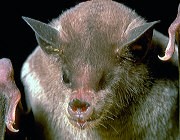- Lesser Long-nosed Bat
Taxobox
name = Lesser Long-nosed Bat
image_caption=Lesser long-nosed bat
regnum =Animalia
phylum = Chordata
classis =Mammal ia
ordo =Chiroptera
familia =Phyllostomidae
genus = "Leptonycteris "
species = "L. yerbabuenae"
binomial = "Leptonycteris yerbabuenae"
binomial_authority = Martinez & Villa, 1940
status=enThe Lesser Long-nosed Bat ("Leptonycteris yerbabuenae") is a medium-sized
bat found in desert scrub regions of the south-westernUnited States andMexico . It is sometimes known as Sanborn's Long-nosed Bat or the Mexican Long-nosed Bat, though the last name is better avoided since it is also used for the entiregenus "Leptonycteris " and for one of the other species in it, theBig Long-nosed Bat "L. nivalis". Enthusiasts for the bats often refer to them simply as Leptos because they are the best known members of the genus "Leptonycteris".Adult Lesser Long-Nosed Bats are yellow-brown or gray above, with rusty brown fur below. Their tails are short and their ears are small. Like all members of the leaf-nosed bat family
Phyllostomidae they have a triangular noseleaf that juts from the end of their noses. They feed mainly onnectar from night-blooming plants such assaguaro ,Organ Pipe Cactus , as well ascentury plant and otheragave s. They are importantpollinator s of night-blooming cactus.Within the US, the Lesser Long-nosed Bat is currently confined to the states of
Arizona andNew Mexico , though its range was formerly greater, extending south intoEl Salvador . They are summer migrants to the US, giving birth to a single pup in May, like theSouthern Long-nosed Bat "L. curasoae". They spend the winter in central Mexico, and mating takes place there during the winter; however some of the bats do not migrate north, and these animals give birth in the winter, presumably after mating in the summer since gestation takes about 6 months. They roost in caves or abandoned mines.Some authorities treat the Lesser Long-nosed Bat as a
subspecies of "Leptonycteris curasoae", designating it as "L. c. yerbabuenae".The Lesser Long-nosed bat is classified as
endangered in both the US and Mexico, though there has been some controversy both about its rarity and its importance as a pollinator. Bat censuses taken before the species was listed as endangered may have missed roosts containing many bats. However even if numbers are higher than once thought, the species remains vulnerable because of its use of a relatively small number of "maternity roosts", and there is no current move to downgrade its conservation status.References
* Species Profile at Bat Conservation International [http://www.batcon.org/SPprofiles/detail.asp?articleID=76]
*ITIS|ID=202347|taxon=Leptonycteris yerbabuenae|year=2006|date=4 FebruaryExternal links
*Some information on this page comes from Threatened and Endangered Species fact sheets for
Pima County, Arizona , at [http://www.co.pima.az.us/cmo/sdcp/sdcp2/fsheets/llb.html]
Wikimedia Foundation. 2010.
